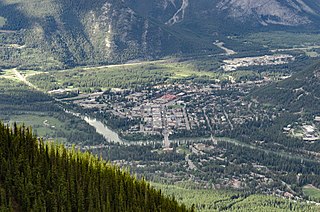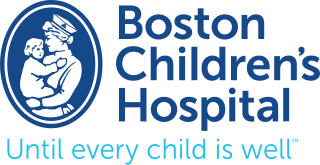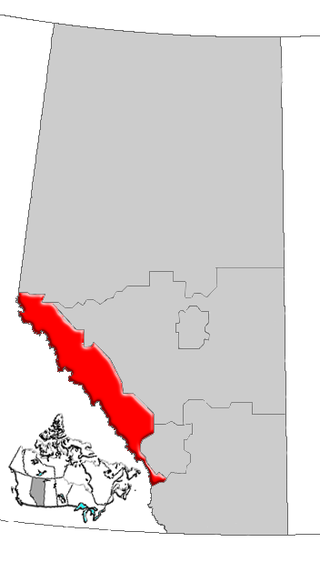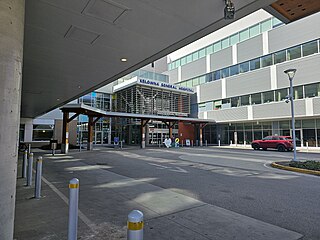
Health informatics is the study and implementation of computer structures and algorithms to improve communication, understanding, and management of medical information. It can be viewed as a branch of engineering and applied science.

Banff is a town in Banff National Park, Alberta, Canada, in Alberta's Rockies along the Trans-Canada Highway, 126 km (78 mi) west of Calgary and 58 km (36 mi) east of Lake Louise, 1,400 to 1,630 m above sea level,

Kootenay National Park is a national park of Canada in southeastern British Columbia. The park consists of 1,406 km2 (543 sq mi) of the Canadian Rockies, including parts of the Kootenay and Park mountain ranges, the Kootenay River and the entirety of the Vermilion River. While the Vermilion River is completely contained within the park, the Kootenay River has its headwaters just outside the park boundary, flowing through the park into the Rocky Mountain Trench and eventually joining the Columbia River. The park ranges in elevation from 918 m (3,012 ft) at the southwestern park entrance to 3,424 m (11,234 ft) at Deltaform Mountain.

The Hospital for Sick Children (HSC), corporately branded as SickKids, is a major pediatric teaching hospital located on University Avenue in Toronto, Ontario, Canada. Affiliated with the Faculty of Medicine of the University of Toronto, the hospital was ranked the top pediatric hospital in the world by Newsweek in 2021.

Massachusetts General Hospital is a teaching hospital located in the West End neighborhood of Boston, Massachusetts. It is the original and largest clinical education and research facility of Harvard Medical School/Harvard University, and houses the world's largest hospital-based research program with an annual research budget of more than $1.2 billion in 2021. It is the third-oldest general hospital in the United States with a patient capacity of 999 beds. Along with Brigham and Women's Hospital, Mass General is a founding member of Mass General Brigham, formerly known as Partners HealthCare, the largest healthcare provider in Massachusetts.

Boston Children's Hospital is the main pediatric program of Harvard Medical School, Harvard University. It is a nationally ranked, freestanding acute care children's hospital located at the centre of Harvard Longwood Medical and Academic Area in Boston, Massachusetts. The hospital is home to the world's largest pediatric research enterprise, and it is the leading recipient of pediatric research funding from the National Institutes of Health. It provides comprehensive pediatric specialties and subspecialties to infants, children, teens, and young adults aged 0–21 throughout Massachusetts, the United States, and the world. The hospital also sometimes treats adults that require pediatric care. The hospital uses the Brigham and Women's Hospital's rooftop helipad and is an ACS verified level I pediatric trauma center, one of three in Boston. The hospital features a regional pediatric intensive-care unit and an American Academy of Pediatrics verified level IV neonatal intensive care unit.

Biotherm is a French skin care company owned by L'Oréal under the Luxury Products division. Biotherm was acquired by L'Oréal in 1970.

Banff Upper Hot Springs are commercially developed hot springs located in Banff National Park in Alberta, Canada, near the Banff townsite. Europeans first became aware of the springs in 1883. As it has been developed since, the hot pool is outdoors and while in the pool, visitors can look across the valley to Mount Rundle. It is located at 1,585 metres (5,200 ft) of elevation, which makes it the highest hot spring in Canada.

An intensive care unit (ICU), also known as an intensive therapy unit or intensive treatment unit (ITU) or critical care unit (CCU), is a special department of a hospital or health care facility that provides intensive care medicine.
Calgary Health Region was formerly the governing body for healthcare regulation in an area of the Canadian province of Alberta. It was amalgamated with other regional health authorities in 2008 to become part of Alberta Health Services. The region administered facilities in the communities of:

Alberta's Rockies comprise the Canadian Rocky Mountains in Alberta, Canada. On the southwestern part of the province along the British Columbia border, the region covers all but the south of Census Division 15.

The University of Alberta Hospital (UAH) is a research and teaching hospital in Edmonton, Alberta, Canada. The hospital is affiliated with the University of Alberta and run by Alberta Health Services, the health authority for Alberta. It is one of Canada's leading health sciences centres, providing a comprehensive range of diagnostic and treatment services to inpatients and outpatients. The UAH treats over 700,000 patients annually.
Alberta Health Services (AHS) is the single health authority for the Canadian province of Alberta and the "largest integrated provincial health care system" in Canada. Headquartered in Edmonton, AHS delivers medical care on behalf of the Government of Alberta's Ministry of Health. It operates 850 facilities throughout the province, including hospitals, clinics, continuing care facilities, mental health facilities and community health sites, that provide a variety of programs and services. AHS is the largest employer in the province of Alberta. In 2019, AHS served 4.3 million Albertans with a staff of 125,000 staff and 10,000 physicians, and an annual budget of $15.365 billion. Sean Chilton is the Acting President and CEO of AHS and reports to Dr. John Cowell, the AHS Official Administrator. The Official Administrator is accountable to the Minister of Health and the Premier.
The Misericordia Community Hospital is an acute care hospital in west Edmonton, Alberta, Canada. The Misericordia is home to the Institute for Reconstructive Sciences in Medicine (iRSM), a facility for reconstruction of the face, head and neck.

The Grey Nuns Community Hospital is an acute care hospital located in the Mill Woods area of south Edmonton, Alberta, Canada. The Grey Nuns Community Hospital provides a full range of services including a 24-hour Emergency Department. The 14-bed tertiary palliative care unit is known for its delivery of care and teaching practices. The hospital traces its roots to the Grey Nuns of Montreal who sent Sister Emery, Adel Lamy and Alphonse to the Edmonton area in 1859.

Kelowna General Hospital (KGH) is a tertiary referral hospital located in Kelowna, British Columbia operated by Interior Health that offers medical care in the Central Okanagan. In British Columbia, Kelowna General is the only hospital outside the Lower Mainland or Vancouver Island that performs angioplasty or cardiac surgery.

Canmore General Hospital is a community hospital located in Canmore, Alberta, Canada. Alberta Health Services is responsible for the operations of the hospital. It is a referral centre for surgical services within the province of Alberta. It contains 25 acute care and 23 long-term care beds. The hospital employs 350 staff with 93 physicians having staff privileges. The hospital primarily refers to the Foothills Medical Centre in Calgary. Nonprofit funding is provided by the Canmore and Area Health Care Foundation.
A death midwife, or death doula, is a person who assists in the dying process, much like a midwife or doula does with the birthing process. It is often a community based role, aiming to help families cope with death, recognizing it as a natural and important part of life. The role can supplement and go beyond hospice. Practitioners perform a large variety of services, including but not limited to creating death plans, and providing spiritual, psychological, and social support before and just after death. Their role can also include more logistical activities, helping with services, planning funerals and memorial services, and guiding mourners in their rights and responsibilities.

The COVID-19 pandemic has impacted hospitals around the world. Many hospitals have scaled back or postponed non-emergency care. This has medical consequences for the people served by the hospitals, and it has financial consequences for the hospitals. Health and social systems across the globe are struggling to cope. The situation is especially challenging in humanitarian, fragile and low-income country contexts, where health and social systems are already weak. Health facilities in many places are closing or limiting services. Services to provide sexual and reproductive health care risk being sidelined, which will lead to higher maternal mortality and morbidity. The pandemic also resulted in the imposition of COVID-19 vaccine mandates in places such as California and New York for all public workers, including hospital staff.

In the waning months of 2022, the first northern hemisphere autumn with the nearly full relaxation of public health precautions related to the COVID-19 pandemic, hospitals in the United States and Canada began to see overwhelming numbers of pediatric care patients, primarily driven by a massive upswing in respiratory syncytial virus (RSV) cases, but also flu, rhinovirus, enterovirus, and SARS-CoV-2.

















